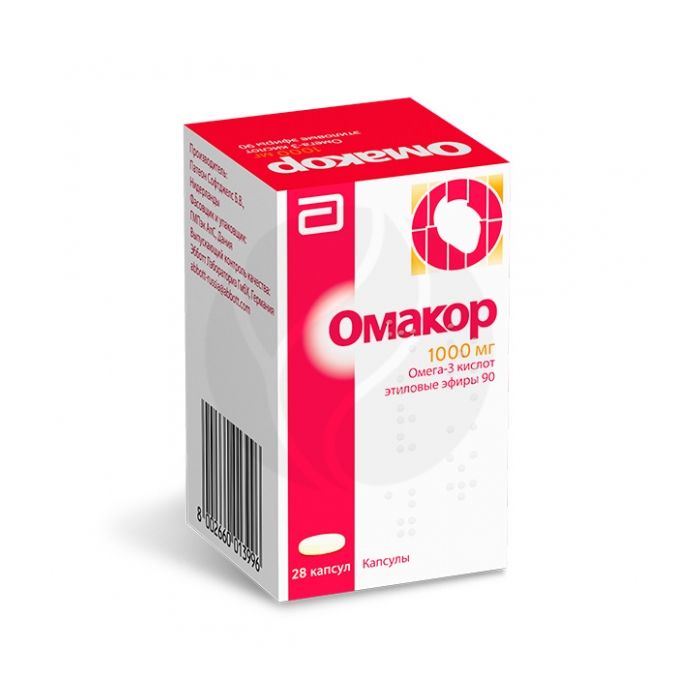Omacor capsules 1000mg, No. 28
Expiration Date: 05/2027
Russian Pharmacy name:
Омакор капсулы 1000мг, №28
Hypertriglyceridemia: endogenous type IV hypertriglyceridemia according to Fredrickson's classification (in monotherapy) as an adjunct to a lipid-lowering diet with its insufficient effectiveness; endogenous hypertriglyceridemia of Ib or III type according to Fredrickson's classification in combination with HMG-CoA reductase inhibitors (statins), when the concentration of triglycerides is insufficiently controlled by the use of statins.
Secondary prophylaxis after myocardial infarction (as part of combination therapy): in combination with statins, antiplatelet agents, beta-blockers, ACE inhibitors.
It is taken orally, during meals, in order to avoid the development of undesirable phenomena from the digestive system.
The dose is set individually, depending on the indications.
Soft gelatin capsules, transparent; size No. 20; the contents of the capsules are a light yellow oily liquid.
In 1 capsule
omega-3-polyunsaturated fatty acids ethyl esters 1000 mg,
? incl. ethyl ester of eicosapentaenoic acid 46%?
docosahexaenoic acid ethyl ester 38%
Excipients:? -Tocopherol - 4 mg.
Exogenous hypertriglyceridemia (type I hyperchylomicronemia); pregnancy; lactation period (breastfeeding); children and adolescents up to 18 years old; hypersensitivity to the active substance.
pharmachologic effect
Lipid-lowering agent. Omega-3 polyunsaturated fatty acids - eicosapentaenoic acid (EPA) and docosahexaenoic acid (DHA) - are essential (essential) fatty acids (NEFA).
Reduces the concentration of triglycerides as a result of a decrease in the concentration of VLDL, in addition, it actively affects blood pressure and hemostasis, reducing the synthesis of thromboxane A2 and slightly increasing the blood clotting time. No significant effect on other factors of blood coagulation was observed.
Delays the synthesis of triglycerides in the liver (by inhibiting the esterification of EPA and DHA). A decrease in the concentration of triglycerides is facilitated by an increase in peroxisomes of beta-oxidation of fatty acids (a decrease in the amount of free fatty acids available for the synthesis of triglycerides). Inhibition of this synthesis lowers the level of VLDL. Raises LDL cholesterol levels in some patients with hypertriglyceridemia. The increase in HDL concentration is minimal and significantly lower than after taking fibrates.
Indications of active substances of the drug Omacor
Hypertriglyceridemia: endogenous type IV hypertriglyceridemia according to Fredrickson's classification (in monotherapy) as an adjunct to a lipid-lowering diet with its insufficient effectiveness; endogenous hypertriglyceridemia of Ib or III type according to Fredrickson's classification in combination with HMG-CoA reductase inhibitors (statins), when the concentration of triglycerides is insufficiently controlled by the use of statins.
Secondary prophylaxis after myocardial infarction (as part of combination therapy): in combination with statins, antiplatelet agents, beta-blockers, ACE inhibitors.
Dosage regimen
It is taken orally, during meals, in order to avoid the development of undesirable phenomena from the digestive system.
The dose is set individually, depending on the indications.
Side effect
From the immune system: rarely - hypersensitivity reactions.
From the side of metabolism: infrequently - hyperglycemia, gout.
From the nervous system: infrequently - dizziness, dysgeusia (taste perversion); rarely headache.
From the side of the cardiovascular system: infrequently - a pronounced decrease in blood pressure.
From the respiratory system: infrequently - epistaxis (epistaxis).
From the digestive system: often - gastrointestinal disorders (including bloating, abdominal pain, constipation, diarrhea, dyspepsia, flatulence, belching, gastroesophageal reflux disease, nausea, vomiting); infrequently - gastrointestinal bleeding, abnormal liver function (including an increase in the activity of AST and ALT). With prolonged use in high doses (4 g / day), belching with the smell or taste of fish is possible.
On the part of the skin and subcutaneous tissues: infrequently - skin rash; very rarely - urticaria.
Contraindications for use
Exogenous hypertriglyceridemia (type I hyperchylomicronemia); pregnancy; lactation period (breastfeeding); children and adolescents up to 18 years old; hypersensitivity to the active substance.
Application during pregnancy and lactation
There are no clinical data on use in pregnancy. It should be used during pregnancy with caution, only after a careful assessment of the risk-benefit ratio, when the expected benefit of therapy to the mother outweighs the potential risk to the fetus.
Use during breastfeeding is contraindicated. If necessary, use during lactation, breastfeeding should be canceled.
special instructions
It should be used with caution in elderly patients (over 70 years old), with impaired liver function, simultaneous administration with oral anticoagulants, with fibrates, hemorrhagic diathesis, with severe trauma, surgery (due to the risk of increased bleeding time).
Experience with secondary endogenous hypertriglyceridemia is limited (especially in uncontrolled diabetes mellitus).
Due to a moderate increase in bleeding time (when used in a high dose), it is necessary to monitor patients with disorders of the blood coagulation system, as well as receiving anticoagulant therapy or drugs that affect the hemostatic system (acetylsalicylic acid as an antiplatelet agent, NSAIDs), and, if necessary, an appropriate correction of the dose of the anticoagulant or agents affecting the hemostatic system.
In some patients, there was an increase in the activity of ACT and ALT (within normal limits), while there are no data indicating an increased risk of using this drug in patients with impaired liver function. It is necessary to monitor the activity of ACT and ALT in patients with signs of impaired liver function (especially when used in a high dose).
Influence on the ability to drive vehicles and use mechanisms
During treatment, there is a small risk of dizziness, which can affect the ability to drive vehicles and engage in other potentially hazardous activities that require increased concentration of attention and speed of psychomotor reactions.
Drug interactions
With simultaneous use with oral anticoagulants and other drugs that affect hemostasis, the risk of increased bleeding time increases.
Simultaneous use with warfarin does not lead to any hemorrhagic complications. However, when combined with warfarin or in case of discontinuation of the course of treatment with this agent, MHO control is necessary.

